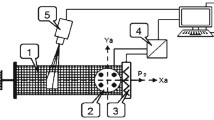Abstract
The orthotropic theory is applied for the nonwoven fabrics that have a preferred orientation direction, the case if the structure is not isotropic. The polynomial regression analysis is employed to allow the attainment of more statistically meaningful information. A functional form based on the transformation rule is developed for the orthotropic approach. The predictions thus obtained are seen to be in excellent agreements with experimental data and the resulting compliances exhibit meaningful relationships for the processing conditions. The compatibility of the compliances from tensile and shear analyses has been explored prior to a practical application of the four compliances defining the in-plane strain-stress field.
Similar content being viewed by others
References
S. Bais-Singh and B. C. Goswami,Textile Res. J.,68, 219 (1998).
S. Bais-Singh and B. C. Goswami,J. Textile Inst.,86, 271 (1998).
S. Bais-Singh, S. B. Biggers, and B. C. Goswami,Textile Res. J.,68, 327 (1998).
P. N. Britton and A. J. Sampson,Textile Res. J.,53, 363 (1983).
S. Erel and S. B. Warner,Textile Res. J.,71, 22 (2001).
T. H. Grindstaff and S. M. Hansen,Textile Res. J.,56, 383 (1986).
B. Pourdeyhimi, R. Dent, and H. Davis,Textile Res. J.,67, 143 (1997).
S. H. Jeong, S. H. Kim, and C. J. Hong,Fiber Polym.,2, 164 (2001)
S. Backer and D. R. Petterson,Textile Res. J.,30, 704 (1960).
D. R. Petterson and S. Backer,Textile Res. J.,33, 809 (1963).
H. S. Kim, A. Deshpande, B. Pourdeyhimi, P. Desai, and A. S. Abhiraman,Textile Res. J.,71, 157 (2001).
H. S. Kim, A. Deshpande, P. Desai, B. Pourdeyhimi, and A. S. Abhiraman,Textile Res. J.,71, 965 (2001).
W. F. Chen and A. F. Saleeb, “Constitutive Equations for Engineering Materials”, pp.175–181, John Wiley and Sons, New York, 1982.
I. M. Ward and D. W. Hadley, “An Introduction to the Mechanical Properties of Solid Polymer”, pp.300–308, John Wiley and Sons, New York, 1993.
B. Pourdeyhimi, R. Dent, and H. Davis,Textile Res. J.,67, 143 (1997).
Author information
Authors and Affiliations
Corresponding author
Rights and permissions
About this article
Cite this article
Kim, H.S. Orthotropic theory for the prediction of mechanical performance in thermally point-bonded nonwovens. Fibers Polym 5, 139–144 (2004). https://doi.org/10.1007/BF02902928
Received:
Revised:
Accepted:
Issue Date:
DOI: https://doi.org/10.1007/BF02902928




